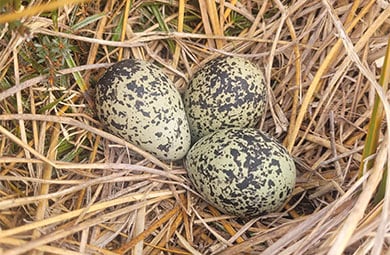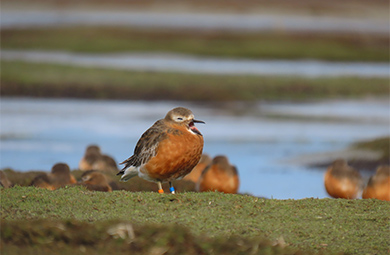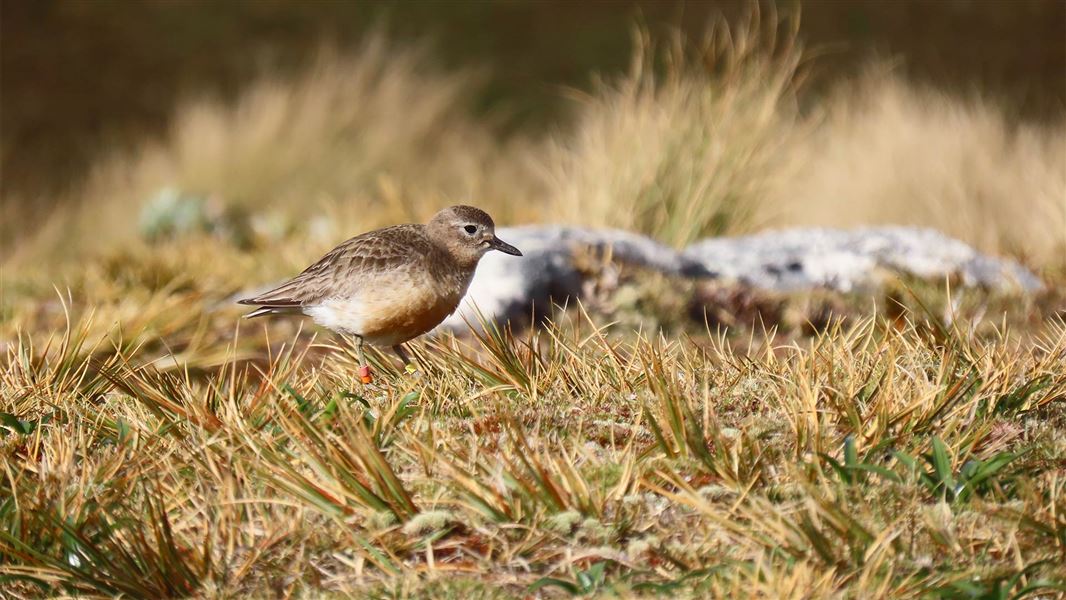New Zealand status: Endemic
Conservation status: Threatened – Nationally Critical
Found in: Rakiura/Stewart Island, visits estuaries and beaches of Southland
Threats: Predation
Sound recordings:
New Zealand dotterel/tūturiwhatu song (MP3, 3,371K)
03:35 – New Zealand dotterel song.
Our bird songs can be reused, even commercially, according to our copyright terms.
Species information: New Zealand dotterel on NZ Birds Online.
Image gallery
Pukunui need your help
One of our most endangered birds, they're on the brink of extinction.
Sadly, our Southern Dotterel/pukunui population has dropped again from 126 in 2023 down to 101 in 2024. In 2009 there were estimated to be 290 pukunui. This is a population decrease of more than 65% since 2009. We need these numbers to go up.
You can help by donating to the New Zealand Nature Fund Dotterel Project.
Or volunteer to help the pukunui on Stewart Island/Rakiura.
Watch our conservation video Underbirds: The Fight to Save the Southern New Zealand Dotterel
History
Other names: Southern red-breasted plover, rako, tūturiwhatu
Southern New Zealand dotterels/pukunui were once widespread throughout the South Island and bred along the Southern Alps. They were recorded breeding as high as 2,500 metres above sea level.
They disappeared from the South Island in the early 1900s following human hunting and the introduction of stoats.
The first ever New Zealand dotterel recorded by European settlers was a Southern New Zealand dotterel seen in Dusky Sound in April 1773. They have since never been recorded in the area or at all along the Fiordland coastline.
In 1991, the Southern dotterel population plummeted to an all-time low of just 62 birds. Thanks to pest control efforts the birds bounced back to almost 300 birds in 2010. However, since then, the population has been in steep decline.
Both the Northern and Southern New Zealand dotterel are culturally significant to Māori. Dotterel bones were highly prized by Māori as traditional tattooing needles.
Distribution
Southern New Zealand dotterels/pukunui only breed on the mountain tops of Stewart Island/Rakiura from September until January and feed on some estuaries/beaches in Southland during the winter. During high tide, many of the birds gather in the sand dunes at Masons Bay.

Pukunui nest on Rocky Mountain
Image: Harrison Talarico | DOC
Characteristics
Breeding
Southern New Zealand dotterels/pukunui breed above the bush line amongst alpine plants and scrub on the mountain tops of Stewart Island/Rakiura.
In August/September, adult birds develop their dark reddish-orange breeding plumage indicating that the breeding season is about to begin. They leave their feeding grounds and head up to the mountain tops in October to start looking for nesting sites.
The breeding season commences in October and runs until early January, with birds laying two to three eggs.
Incubation lasts around 30 days and fledging is estimated to take about 6 weeks.
Due to high predation of adult birds, there is a gender bias in the population with more females than males which can lead to female pairs with nests of 4 to 6 infertile eggs.
Colours

Pukunui in full breeding plumage at Awarua Bay
Image: Daniel Cocker | DOC
Adult Southern New Zealand dotterels/pukunui go through dramatic colour changes during the year.
From March/April through to June the birds have a pale white chest, sometimes with a few small patches of orange. From June, their chest becomes more orange and completely dark reddish-orange by September/October.
From October to January the birds are away nesting on the hill tops and their colouring fades. By March their chests will become pale white again. This cycle then repeats.
Juveniles are believed to have a pale chest year-round, occasionally with a few small orange patches.
Feeding
Southern dotterels consume a wide range of invertebrates, crabs and small fish. They feed at estuaries and beaches but during the breeding season can be found feeding on the alpine grasslands above the bush line.
Threats
Did you know?
New Zealand dotterel will fake an injury to draw intruders away from their nest.
Unlike the North Island and South Island, Stewart Island/Rakiura is free of introduced mustelids (stoats, weasels and ferrets) which are deadly to dotterels.
It does have feral cats which are widespread throughout the island. Cats kill chicks and adult dotterels, and eat eggs.
In the winter, about a third of the population flies to Awarua Bay near Bluff for feeding where they are at risk of predation by mustelids.
Other threats include the various rat species found on Rakiura and possums. White-tailed deer have been caught on nest cameras eating dotterel eggs.
Spur-wing plovers, Australasian harriers and black backed gulls also threaten the dotterels.
Population decline
In 2022, Rakiura experienced higher-than-average rat numbers as a result of a mast or heavy fruiting event. This event created a greater food source that fuelled rat populations which in turn led to a larger number of feral cats.
Rats are the preferred prey to feral cats. When rat numbers drop, feral cats look for alternative prey such as Southern New Zealand dotterel. It is estimated that 40 to 50 birds died during the most-recent breeding season. Fortunately, some adults were able to successfully breed and raise chicks to fledge which softens the decline.
Conservation
DOC has four permanent dotterel rangers who live on Rakiura and undertake pest control in Southern New Zealand dotterel/pukunui breeding areas, monitor nests and undertake population counts.
The dedicated field rangers are increasing feral cat control in dotterel breeding areas in preparation for the upcoming breeding season, from October until early January.
Watch our video about the fight to save pukunui on Stewart Island / Rakiura.
Banding
It is estimated that 80 to 90% of the population is banded. These leg bands help us to identify individuals and enable us to estimate the total population. Each bird generally has 1 metal band and 2 or 3 colour bands.
Bird band combinations can be read from left to right: left leg first followed by the right leg. There will always be a metal band on the left leg. The metal band can be hard to spot.
If you see a Southern New Zealand dotterel and are able to read its band combination or get a photo of its bands, report it to the DOC Rakiura National Park Visitor Centre.
